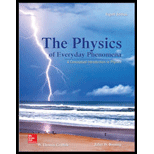
(a)
The mass per unit length of the rope.
(a)
Answer to Problem 1SP
The mass per unit length of the rope is
Explanation of Solution
Given info: The length of the rope is
Write the equation to find the mass per unit length of the rope.
Here,
Substitute
Conclusion:
Therefore, the mass per unit length of the rope is
(b)
The speed of the waves formed in the rope.
(b)
Answer to Problem 1SP
The speed of the waves formed in the rope is
Explanation of Solution
Given info: The tension in the rope is
Write the equation to find the velocity of waves formed in a rope under tension.
Here,
Substitute
Conclusion:
Therefore, the velocity of the waves formed in the rope is
(c)
The wavelength of the waves formed in the rope.
(c)
Answer to Problem 1SP
The wavelength of the waves formed in the rope is
Explanation of Solution
Given info: Frequency of the waves in the rope is
Write the equation to find the wavelength of the waves formed in the rope.
Here,
Substitute
Conclusion:
Therefore, the wavelength of the wave formed in the rope is
(d)
The number of complete cycles of wave that will fit on the rope.
(d)
Answer to Problem 1SP
The number of complete cycles of waves that is formed in the rope is
Explanation of Solution
The length of rope used is
Therefore the number of wave cycles that will be completed in the rope is found by just dividing the total length by wavelength.
Write the equation to find the number of wave cycles completed.
Here,
Substitute
Conclusion:
Therefore, the number of wave cycles in the rope is
(e)
The time taken by the leading edge of the waves to go and come back from the edge of the rope.
(e)
Answer to Problem 1SP
The waves take a time of
Explanation of Solution
The waves need to travel a distance of
The time taken by a wave to complete one cycle of motion is called time period. We have two cycles here and so we have to multiply the time period for one cycle by two to get the time period for two cycles.
Write the equation to find the time period of two cycles of waves.
Here,
Substitute
Conclusion:
Therefore, the time taken by the waves to reach and start back again from the end of the rope is
Want to see more full solutions like this?
Chapter 15 Solutions
The Physics of Everyday Phenomena
- A man slides two boxes up a slope. The two boxes A and B have a mass of 75 kg and 50 kg, respectively. (a) Draw the free body diagram (FBD) of the two crates. (b) Determine the tension in the cable that the man must exert to cause imminent movement from rest of the two boxes. Static friction coefficient USA = 0.25 HSB = 0.35 Kinetic friction coefficient HkA = 0.20 HkB = 0.25 M₁ = 75 kg MB = 50 kg P 35° Figure 3 B 200arrow_forwardA golf ball is struck with a velocity of 20 m/s at point A as shown below (Figure 4). (a) Determine the distance "d" and the time of flight from A to B; (b) Determine the magnitude and the direction of the speed at which the ball strikes the ground at B. 10° V₁ = 20m/s 35º Figure 4 d Barrow_forwardThe rectangular loop of wire shown in the figure (Figure 1) has a mass of 0.18 g per centimeter of length and is pivoted about side ab on a frictionless axis. The current in the wire is 8.5 A in the direction shown. Find the magnitude of the magnetic field parallel to the y-axis that will cause the loop to swing up until its plane makes an angle of 30.0 ∘ with the yz-plane. Find the direction of the magnetic field parallel to the y-axis that will cause the loop to swing up until its plane makes an angle of 30.0 ∘ with the yz-plane.arrow_forward
- A particle with a charge of − 5.20 nC is moving in a uniform magnetic field of (B→=−( 1.22 T )k^. The magnetic force on the particle is measured to be (F→=−( 3.50×10−7 N )i^+( 7.60×10−7 N )j^. Calculate the y and z component of the velocity of the particle.arrow_forwardneed answer asap please thank youarrow_forward3. a. Determine the potential difference between points A and B. b. Why does point A have a higher potential energy? Q = +1.0 C 3.2 cm 4.8 cm Aarrow_forward
 College PhysicsPhysicsISBN:9781305952300Author:Raymond A. Serway, Chris VuillePublisher:Cengage Learning
College PhysicsPhysicsISBN:9781305952300Author:Raymond A. Serway, Chris VuillePublisher:Cengage Learning University Physics (14th Edition)PhysicsISBN:9780133969290Author:Hugh D. Young, Roger A. FreedmanPublisher:PEARSON
University Physics (14th Edition)PhysicsISBN:9780133969290Author:Hugh D. Young, Roger A. FreedmanPublisher:PEARSON Introduction To Quantum MechanicsPhysicsISBN:9781107189638Author:Griffiths, David J., Schroeter, Darrell F.Publisher:Cambridge University Press
Introduction To Quantum MechanicsPhysicsISBN:9781107189638Author:Griffiths, David J., Schroeter, Darrell F.Publisher:Cambridge University Press Physics for Scientists and EngineersPhysicsISBN:9781337553278Author:Raymond A. Serway, John W. JewettPublisher:Cengage Learning
Physics for Scientists and EngineersPhysicsISBN:9781337553278Author:Raymond A. Serway, John W. JewettPublisher:Cengage Learning Lecture- Tutorials for Introductory AstronomyPhysicsISBN:9780321820464Author:Edward E. Prather, Tim P. Slater, Jeff P. Adams, Gina BrissendenPublisher:Addison-Wesley
Lecture- Tutorials for Introductory AstronomyPhysicsISBN:9780321820464Author:Edward E. Prather, Tim P. Slater, Jeff P. Adams, Gina BrissendenPublisher:Addison-Wesley College Physics: A Strategic Approach (4th Editio...PhysicsISBN:9780134609034Author:Randall D. Knight (Professor Emeritus), Brian Jones, Stuart FieldPublisher:PEARSON
College Physics: A Strategic Approach (4th Editio...PhysicsISBN:9780134609034Author:Randall D. Knight (Professor Emeritus), Brian Jones, Stuart FieldPublisher:PEARSON





